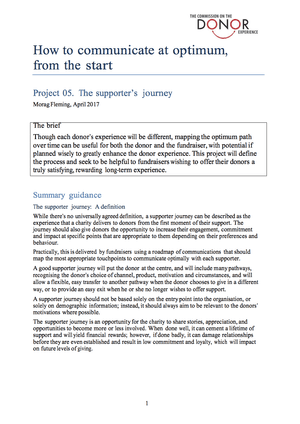CDE project 5 section 4: King’s College London and King’s Health Partners supporter journey
- Written by
- The Commission on the Donor Experience
- Added
- April 24, 2017
In 2011, the Development and Alumni Office of King’s College London integrated with the fundraising teams of Guy’s and St Thomas’ Charity, Maudsley Charity and King’s College Hospital Charity to create a single fundraising and supporter development office (F&SD) under the joint leadership of King’s College London and King’s Health Partners. After the initial three year period of integrating all the necessary fundraising functions and the development of the engagement programmes, the decision to develop a supporter journey project, focusing on supporters and donors within our mass audiences was taken in 2014.
The aim of the supporter journey project was to look at how the F&SD department could become more ‘supporter-centric’ in order to maximise consideration and conversion as cost effectively as possible. Fundamentally, this meant ensuring that the department was communicating the right things to the right people at the right time across the entire database.
From the beginning of the project, it was important to have a clear idea of how success would be identified. Essentially, this came down to three key areas:
- A clear and agreed supporter segmentation on which all communication plans are based.
- Greater insight – knowing the right things in order to determine the plan.
- Working practices – demonstrably different and joined up.
We already had two very distinct audiences to begin with: our KCL alumni and our hospital supporters. So we knew we’d need to look at different journeys for each of these groups. Through a combination of qualitative and quantitate research and analysis and various project groups with staff involved from across the department, we were also able to identify three key segments within each of the alumni and hospital audiences. We knew that we would need to consider and develop quite different journeys for each segment.
Alumni segments
- New graduates.
- Non-donors, alumni aged 40 and over.
- Supporter once alumni donors.
Hospital segments
- New graduates.
- Non-donors, alumni aged 40 and over.
- Supporter once alumni donors.
The whole initiative has been a cross team effort from the very start. We knew that the most important outcome would be to ensure that our fundraising and engagement programmes were fully joined up, and that all relevant teams within the F&SD department were focussed on the same key segments and incorporated them into their plans. While the main driver was ultimately to see an uplift in income we ensured that the key segments were incorporated with the operational planning templates for all relevant teams within the department, so that annual plans could focus on deliverables for these key segments, in terms of both financial and non-financial activities e.g. events/engagement/communications. KPIs were agreed across teams and regular working group meetings for each key segment have helped to keep momentum and ensure that plans are joined up and complement each other.
It’s important not to try to implement too many things at once, to avoid not being able to measure what is and isn’t working. For us it has been important to get the thanking and welcome processes right and ensure that we’re able to deliver these promptly and consistently to all donors, no matter their entry point. It needs to work for existing channels but also for any new acquisition initiatives, so it’s important to take time to get those right from the start.
It’s also important to ensure that messaging is consistent through the journey. There’s no use in having a thank-you letter and welcome pack which says one thing, but then your supporter newsletter/website/stewardship says something completely different.
While the uplift in income has been the main focus, for our alumni relations team it was also important to recognise the role of the supporter journey in the transition between students to alumni. Therefore there has been a real focus on student engagement to ensure that when we engage with them as alumni in future, again we have that consistency of message.
Another key element is making sure that all data selections across the department are using the same segment definitions and work very closely with data teams to make sure everything is captured effectively on the database for future tracking and analysis.
Feedback has been quite difficult to measure, since as far as donors are concerned, they may not have noticed any significant changes and we’re still at the early stages of implementation. We haven’t yet planned to repeat the qualitative and quantitate research which was carried out at the very beginning of the process, but it’s something we are mindful about. We’ll be monitoring the impact on donor numbers and retention rates over the next year or so, which will be the most important measure of whether it’s working.























